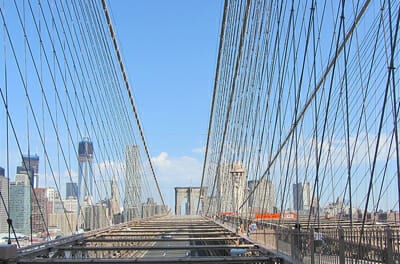
Global Steel Consumption and the Largest Steel Structures in the World
Chicago, IL – Construction is one of the biggest steel consumers on the planet, using about 30 percent of worldwide steel production. With steel consumption forecasted by the World Steel Association to be 1.455 billion metric tons in 2013, that makes for an incredible amount of steel going into some really massive structures.
Part of what makes steel consumption for construction so big is the amount of steel that is used for the construction of huge structures such as bridges, skyscrapers, and other large buildings. A single steel building can use many tons of steel in its design. With the need to make more and more skyscrapers and other large mega-building projects, the amount of steel consumed adds up rather quickly.
There are several ways that the size of structures can be rated, each of which would give us a different idea of what the largest are. If height is used, then some skyscrapers would win. If width is used, then some of the largest suspension bridges would clearly be the winners. On the other hand, if total mass of steel used in the construction were the deciding factor, a third group of structures would be the winners. So, we’re not going to try and decide which are the biggest, just look at some of the biggest.
For a building or other structure to be considered “steel” the Council of Tall Buildings and Urban Habitat says that the main vertical and lateral structural elements along with the floor systems must be constructed of steel. Most buildings don’t qualify as steel buildings by this definition, as the majority of the structure is concrete. Buildings which use a combination of the two are considered composite.
The Beijing National Stadium, commonly referred to as “The Bird’s Nest,” which was built for the 2008 Olympics is considered to be the largest steel structure in the world today. This massive steel structure was originally conceived to support the retractable roof that the design specifications called for. Later revisions removed the retractable roof as a cost savings, leaving the Bird’s Nest in place.
The Bird’s Nest uses a total of 110,000 tons of steel. Three are 24 trussed columns as the main supports, each of which uses 1,000 tons of steel. While there are many interesting things about the design and building of this structure, one of the most interesting is that it serves no purpose other than aesthetics. The steel structure does not support the stands, which are a concrete structure that is 50 feet inside The Bird’s Nest. It was intended to support the roof, which was removed from the design.
Looking at other massive decorative structures, we find the Gateway Arch in St. Louis, Missouri. Completed in 1965, this steel structure is still the largest monument in the United States, standing 192 meters tall. Nine hundred tons of stainless steel was used in its construction.

The tallest steel skyscraper ever built is the Willis Tower, formerly known as the Sears Tower. Completed in 1973, it is still the tallest building in the United States, although it is the seventh tallest free-standing structure in the world. Taller buildings use a composite construction, not qualifying to be considered steel buildings.
The Sears Tower, as it was then known, used a very unique structural design, which has been used in almost all skyscrapers since its construction. Referred to as Khan’s bundled tube structure, the building consists of nine hollow steel tubes, bundled together. All nine tubes rise the first 50 stories, with seven continuing past that point. Pairs of tubes are dropped out of the design at periodic levels, leaving only two tubes to rise the full 108 floors.
The longest all steel suspension bridge ever constructed is the Brooklyn Bridge in New York City. This massive structure has a total length of 1825 meters. It was the first to use steel wires for the suspension part of its structure in 1883. Today, over 100 years later, this iconic bridge still serves its original purpose.



